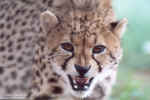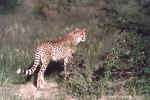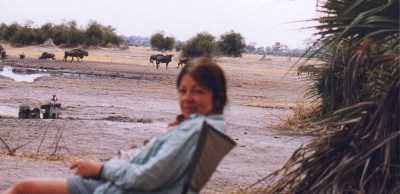A Handful: Caring for Cheetahs

Twenty-six cheetahs eat a lot: an
average of 2 kgs. (4 lbs.+) per adult, and about 1.5 kgs (3 lbs.+) per cub.
Adults fast on Sundays, but the little ones must eat every day.
Cheetahs are fussy eaters. In the wild,
they like fresh meat, preferably killed by them. In captivity, they are
given fresh
meat --usually donkey, fortified with calcium and other minerals. It was our job,
at times,
to cut up and prepare about 100 lbs. of meat for these hungry
beauties.
 While
cutting meat wasn't fun, feeding them was a thrill. They would all run
into the feeding pen like there was no tomorrow, and we would stand there
and watch them enjoy their meal. I could just stay there watching and
listening to them all day long.
While
cutting meat wasn't fun, feeding them was a thrill. They would all run
into the feeding pen like there was no tomorrow, and we would stand there
and watch them enjoy their meal. I could just stay there watching and
listening to them all day long.  They
were actually quite organized and would argue just a little whenever there was a
particularly appetizing chunk of meat, I guess. We always had to make
sure that Gremlin, one of the smallest cubs, got her fair share, since the
others seemed to know that they could bully her.
They
were actually quite organized and would argue just a little whenever there was a
particularly appetizing chunk of meat, I guess. We always had to make
sure that Gremlin, one of the smallest cubs, got her fair share, since the
others seemed to know that they could bully her.
Hungry
creatures can produce lots of poop. Sometimes our job was to clean that
and any other debris from some of the pens --always accompanied by a CCF
person. Only the 10 cubs' pen, the Old Lady's, and Peggy's, were
"cleanable", as none of these cats are slated for release and
therefore are allowed human presence. The Three Boy's pen was off
limits. Even thought they will not go back in the wild, they are too big
and powerful for anyone to go in.
The
pens are large, and it is fun to clean them. Normally, the cubs would run
toward us just in case we had food for them (sometimes I wondered whether they
would think we WERE food).  Disillusioned,
they would go back to whatever it was that they were doing. We would count
them to make sure that we knew where they were. Sometimes they would
simply be resting under a tree or by the fence, and that was when our job was easier.
Disillusioned,
they would go back to whatever it was that they were doing. We would count
them to make sure that we knew where they were. Sometimes they would
simply be resting under a tree or by the fence, and that was when our job was easier.
 Other
times we just couldn't find them so easily. Their
camouflage is so amazing that they would disappear in the tall grass and we had
to make sure not to step on them. Only by being very observant were
we able to make sure that they --and us, were safe.
Other
times we just couldn't find them so easily. Their
camouflage is so amazing that they would disappear in the tall grass and we had
to make sure not to step on them. Only by being very observant were
we able to make sure that they --and us, were safe.
 Most
of the time they would let us do our jobs. Other times, they would try to
'play' and we had to use a
stick which, even though it never touched them, kept them at bay. This was
especially helpful with the one rowdy cub who loved to cause trouble. In
fact, this bad boy and his two siblings had to be fed in a separate feeding
pen. They were larger than the other seven and could have easily taken food
away from them.
Most
of the time they would let us do our jobs. Other times, they would try to
'play' and we had to use a
stick which, even though it never touched them, kept them at bay. This was
especially helpful with the one rowdy cub who loved to cause trouble. In
fact, this bad boy and his two siblings had to be fed in a separate feeding
pen. They were larger than the other seven and could have easily taken food
away from them.
The poop
didn't just get picked.  It also had to be prepared for testing, which
helps to determine the cheetahs' stress levels. This was particularly
important in the case of the cubs that were going to travel to the US. The
poop had to be cleaned of grass or debris as much as possible, put into test
tubes, mixed with ethanol, sealed and labeled. We did so much of this that
eventually we would be amused at the pretty flowers we found in some of our
"samples".
It also had to be prepared for testing, which
helps to determine the cheetahs' stress levels. This was particularly
important in the case of the cubs that were going to travel to the US. The
poop had to be cleaned of grass or debris as much as possible, put into test
tubes, mixed with ethanol, sealed and labeled. We did so much of this that
eventually we would be amused at the pretty flowers we found in some of our
"samples".
Preparing feces
for testing is definitely not the
most glamorous job I've ever done, and neither is cutting donkey meat for that
matter. Swarms of flies would surround us, and
the 'aromas' were not the sweetest I've ever smelled, but looking at the cheetahs everyday made it
worth every second of it.


